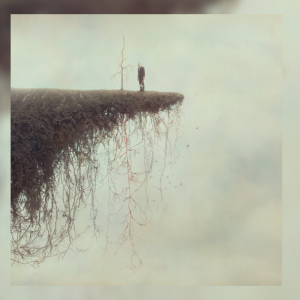The cover of the third album by The Gloaming shows a man on the edge of a field that dangles precipitously into space, its roots floating in nothingness. It’s a disquieting image, and one illustrative of the challenge the band faces as it attempts to stay in touch with the roots of the tradition while navigating through far more rarefied airs.
The opening track, Meáchan Rudaí, is a setting of a poem by Cork writer Liam Ó Muirthile. Ó Muirthile’s words deal with filial grief, the cutting of maternal ties, and the inescapable weight of existence. But they’re also apt images for a music that weighs and tests its own bonds to the motherlode of tradition. The opening is more like ’70s minimalism than folk, with Iarla Ó Lionáird intoning over a brooding piano and guitar ostinato. It takes well over a minute for the other players to join in and for the piece to settle into the home key, at exactly the moment Ó Lionáird sings “Meáchan cheol do ghutha ón tuath sa chathair”.
Meáchan Rudaí is a touching elegy to a shared life lost. But as played by The Gloaming it’s equally a statement of intent. This is rural folk music that has uprooted itself for a modern urban world, music that feels “the weight of the music of your country voice in the city”. Over the rest of the album, it’s also music that proves itself the equal of the finest aural art being created in any genre right now.
There’s much here that recalls the band’s previous work. The Lobster has Martin Hayes’s fiddling floating through airy high arpeggios from pianist Thomas Bartlett, before Caoimhín Ó Raghallaigh takes up the tune, spins it round, and passes it back to Hayes. It exemplifies the genius of the group. Traditional Irish music is essentially melodic, but previous crossover musicians like Horslips have found ways to channel that melodic flow through the harmonies of popular music. However, The Gloaming is the first group to stretch it through the larger-scale harmonic forms of contemporary classical and jazz..
Those forms are more prominent than ever on this album, with Bartlett taking a much bigger role as arranger and producer. Áthas is again based around words from Liam Ó Muirthile, but the opening piano figures could be Nils Frahm’s, and there’s more than a hint of Max Richter on My Lady Who Has Found The Tomb Unattended.
All of this highlights the fact that where previous Gloaming albums were very much a record of five musicians sharing the same stage, this is more a calculated work of arrangements and studio overdubs. While those arrangements are consistently flawless, they sometimes lack the instinctive energy that pulsed through every track of last year’s ‘Live At The NCH.’ For example, The Pink House is immaculately played but ultimately inconsequential, and Ó Lionáird’s echoed vocals on the verses of Reo veer perilously close to new age blandness.
This is partly because Martin Hayes is a much quieter presence here than on previous albums. It’s a shame: where he’s given free rein, as he is on The Old Road To Garry and the Sheehan’s Jigs medley, the music is palpably more energetic. It builds irresistibly across those long harmonic arcs to climaxes where you can hear feet tapping and Cahill’s pick digging into his guitar strings.
This is a superb album nonetheless. The opening track is the most haunting music Ó Lionáird has written since Seacht on his debut solo album over 20 years ago, and the closing one, Amhrán na nGleann, is nua nós, a keen of mourning for the 21st century. But though it begins and ends with death, there’s nothing morbid about it. The music and the tradition it comes from are stretched at times to breaking point, but they remain absolutely vital.



